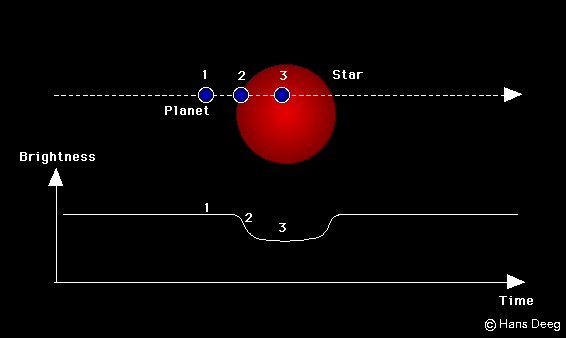The universe is an ever changing place; or least it is to astronomers. Most of us when we were in school remember that there were only nine planets in the entire universe. Now there are eight planets in our solar system, several named Pluto-sized objects near the Kuiper Belt, and more than 200 discovered planets in faraway solar systems.
The consistent, repeated discovery of exoplanets is very exciting to the astronomical field. The process of discovering exoplanets is very intriguing indeed. There are actually two primary methods for exoplanet discovery: the transit method and the wobble method. In the wobble method, a large planet, like Jupiter, orbitting a star causes a slight wobble in the star and it moves slightly off of its center of gravity, like in the illustration. By making measurements of the star's "wobble" we can determine many characteristics of the planet. Nearly all exoplanets have been discovered using this method, but the method is severely limited: it can detect Jupiter-sized objects, but not Earth-sized objects. It is difficult, if not impossible, to determine what the composition of the planet is.
In the wobble method, a large planet, like Jupiter, orbitting a star causes a slight wobble in the star and it moves slightly off of its center of gravity, like in the illustration. By making measurements of the star's "wobble" we can determine many characteristics of the planet. Nearly all exoplanets have been discovered using this method, but the method is severely limited: it can detect Jupiter-sized objects, but not Earth-sized objects. It is difficult, if not impossible, to determine what the composition of the planet is. In the transit method, we can get much more information. The planet passes directly in front of the star. We can get mass, size, and even atmospheric information from this method, because light from the star pass through the upper atmosphere of the planet, which even allows for temperature and cloud formation measurements. The transit method unfortunately can provide many false detections and also many undiscovered planets will not pass perfectly in alignment with observations.
In the transit method, we can get much more information. The planet passes directly in front of the star. We can get mass, size, and even atmospheric information from this method, because light from the star pass through the upper atmosphere of the planet, which even allows for temperature and cloud formation measurements. The transit method unfortunately can provide many false detections and also many undiscovered planets will not pass perfectly in alignment with observations.
- Gravitational Microlensing
- Circumstellar Disks
- Pulsar Timing
- Astrometry
- Direct Imaging
 The vast majority however are discovered by the two afforementioned methods. Direct imaging is great though, because even though discoveries made with this method are rare, they do exist and for the first time give us a peek into neighboring star systems, like this picture of GQ Lupi and its planetary companion GQ Lupi b.
The vast majority however are discovered by the two afforementioned methods. Direct imaging is great though, because even though discoveries made with this method are rare, they do exist and for the first time give us a peek into neighboring star systems, like this picture of GQ Lupi and its planetary companion GQ Lupi b.




|